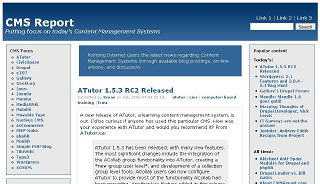Quoting IT: Corporate Blogs
"The equity a corporate blogger builds up is portable, in other words. Rather than sticking to the company, it will follow the blogger—even if the blogger heads to a competitor."
- Nicholas Carr, Lessons in Corporate Blogging, BusinessWeek Online, July 17, 2006.
They Hate Drupal, They Love Drupal
Does Drupal make the grade? The answer to that question evidently depends on who you ask. Last week, the Tech Republic posted a review by Justin James on the Drupal content management system. Mr. James concluded that "Overall, Drupal does not make the grade". This week the Drupal community is all a buzz over the decision for IBM's developerWorks to use Drupal for designing, developing, and deploying a collaborative Website.
Firefox 2 Beta 1 has been released
Just wanted to write a quick note that the first actual beta for Firefox 2 has been released. I'm proud to say that I'm currently using the beta Internet browser as I'm writing this post. The built-in spell checker for text boxes (found in on-line forms and Web content management systems) works great! I'm also pleased to say, that the spell checker works with TinyMCE.
A couple months ago, I posted some of the features that were likely to be included in Firefox 2.0 once it reaches final release. My original list of features wasn't too far off the mark. According to the release notes, the following are new features that have been included since Firefox 1.5 was released:
Mitchell Baker: Innovation vs Stability
Mozilla's Mitchell Baker wrote an interesting post about product development. As you develop a product and customer loyalty there is a risk to making too many changes to a product. However, the success of your product likely came about because of innovation. If you kill off introducing new ideas and concepts for your product you are also likely to kill off the reason your product became successful in the first place.
Radiant: A Ruby CMS and PHP alternative
So far I've mostly posted here at CMS Report about PHP-based content management systems. However, PHP isn't the only language being used on the Web. Other Web friendly languages include Perl, Java, Ruby, ASP, Python, etc.
So for one of our first non-PHP based CMS we're going to take a look at Radiant. The Radiant CMS is a Ruby on Rails CMS that has yet to reach version 1.0. Like a lot of CMS in early development it is considered a "no fluff" CMS for small teams. In other words, Radiant is not quite ready for enterprise level work. Radiant however may work well for those personal sites and small companies that have an invested interest to promote Ruby on Rails based applications.
New Drupal 4.7 theme available... Blue_mark
 Something old is new again. The Blue_mark theme for Drupal 4.7 is available at CMS Report. The Blue_mark theme uses Drupal 4.7's default theming engine, PHPTemplate. This theme is released under the GPL.
Something old is new again. The Blue_mark theme for Drupal 4.7 is available at CMS Report. The Blue_mark theme uses Drupal 4.7's default theming engine, PHPTemplate. This theme is released under the GPL.
The Blue_mark theme was originally offered by Charles Lowe and available for download at his site, cyberdash.com. The original theme was written for Drupal 4.4's Xtemplate theme engine. I maintained the theme through Drupal 4.6 for a personal site of mine. With the switchover to the PHPTemplate theme engine as the Drupal 4.7 defualt, significant work was needed to keep old Blue_mark alive. The Blue Marine theme was used as a starting point. Minor tweaks were made to Blue Marine's PHP files and significant changes were made in the CSS.
Dizzying Thoughts of Drupal Developer, Nick Lewis
A post by Nick Lewis, Drupal and XML: Looking Forward, caught my attention. In his post he discusses work on developing the CAP XML format (Common Alerting Protocol).
In preparation for my /Nick Lewis/ trip to Washington D.C. next month, I’ve begun to develop a module that integrates the CAP XML format (Common Alerting Protocol) with drupal’s node, location, google map, category, and CCK modules.
Put plainly, the CAP format seeks:


